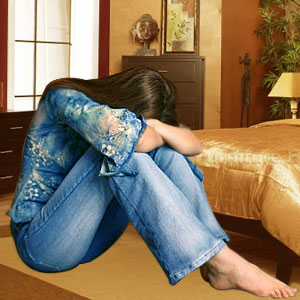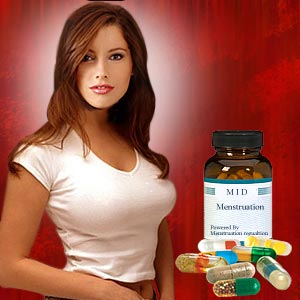Painful Menstrual Cramps

Curling up on the floor, clutching the abdomen and writhing in pain is common with women who suffer painful menstrual cramps. The intensity varies from woman to woman. From mildly annoying to excruciating, menstrual cramps can put a dent in a woman's day(s). Not everyone is lucky to be in Korea where female students would not be penalized for taking off on those days and the female workers can avail once-a-month menstrual leave.
There are many ways to relieve menstrual cramps . Home remedies to relieve painful menstrual cramps are not only natural but safe and effective too. Check out the causes, symptoms and various ways to relieve menstrual cramps.
Menstrual cramps
Some pain and discomfort during menstruation is normal. But not to that extent that it interferes and affects normal functioning for a day or two during each menstrual cycle. Dysmenorrhea is the medical term for the painful cramps that may occur in the abdominal (belly) and pelvic areas immediately before or during the menstrual period.
Dysmenorrhea is of two types, primary and secondary dysmenorrhea. The advantage of understanding the symptoms and causes of primary and secondary dysmenorrhea is that it helps determine the need to seek medical help.
Primary/functional dysmenorrhea
- Typically occurs in adolescents.
- Pain usually is felt in the lower abdomen or back and can be mild to severe.
- Cramps may begin within 6 months or 2-3 years following menarche, the beginning of menstruation.
- Menstrual cramps often start shortly before or at the onset of the period and last for one to three days.
- As a woman ages, the intensity of cramps may decrease or stop entirely. In most women, the cramps disappear after delivering a baby.
- Pain is not due to any disease or abnormality in the womb or female reproductive tract.
Causes of menstrual cramps
The cramps are caused by strong or exceptionally lengthy contractions of the uterus. Researches on the subject indicate that these contractions occur when the supply of blood to the uterus lining is reduced, which may be linked to an overproduction of prostaglandin, hormone-like substance, normally found in the body. Prostaglandin is known to stimulate uterine contractions.
There is another possible cause, which is a heavy menstrual flow with blood clots, which makes the cervix to dilate (widen) and cause intense cramping. There are some factors that may worsen the pain like uterus that tips backward instead of forward, lack of exercise, stress, family history, obesity and smoking.
Symptoms: In addition to pain other symptoms may include headache, diarrhea, constipation and urinary frequency and fainting.
Secondary Dysmenorrhea
More frequent in women in the age group of 20s and 30s.
Pain is usually felt in the lower abdomen, which can extend to the lower back and legs.
Pain usually begins earlier in the menstrual cycle and lasts longer than common menstrual cramps.
Not necessarily a continuous pain, it could be periodic cramping, a dull, constant ache or a sharp, stabbing sensation.
Mild, moderate and severe depending on the intensity of the pain and associated discomforts.
Causes: A disease in the woman's reproductive organ causes secondary dysmenorrhea. Certain conditions are attributed that can cause secondary dysmenorrhea like endometriosis, pelvic inflammatory disease, adhesions or an IUD that does not have hormones, cervical steriosis and tumors or fibroids.
Obesity, cigarette smoking, high stress levels, family history of dysmenorrhea, history of pelvic infection, history of STD infection are considered to be risk factors that increases the chance of secondary dysmenorrhea.
Depending on the symptoms, secondary dysmenorrhea is classified as mild, moderate and severe. Mild dysmenorrhea causes pelvic discomfort, cramping or a heavy feeling on the first day of bleeding with no other symptoms. Moderate secondary dysmenorrhea lasts for two to three days and may be accompanied by general feelings of discomfort, nausea, vomiting, bloating and diarrhea. Along with pain, typical symptoms of severe secondary dysmenorrhea, which lasts two to seven days, include gastrointestinal upset, back and leg pain and headache.
Relieve menstrual cramps
Menstrual cramps do not continue in a set pattern or same intensity every month. One month the cramps might be mild or worse than another. It depends on ovulation. Irrespective of the severity of menstrual cramps, the uneasiness associated with it can make those few days harder. If your health care provider has ruled out an underlying condition as a cause for painful menstrual cramps, you can consider options to relieve menstrual cramps. There are several ways to ease painful menstrual cramps.
The most common method adopted universally to get instant relief is by taking painkillers. Instant relief yes, but regular intake is not advisable. Research indicates, that regular consumption of such medicines could adversely affect the ability of a woman to conceive.
To be on the safe side, consider natural home remedies to relieve menstrual cramps. There are many easy, effective and safe self-help methods to relieve menstrual cramps. Home remedies not only relieve menstrual cramps but also reduce or eliminate associated risk factors such as stress, depression, anxiety etc. Prefer a holistic approach.
Here are ways to relieve menstrual cramps and symptoms like backache, lack of appetite, overeating, exhaustion and lowered resistance to ailments. Usually women start using these home remedies a few days before the cycle starts and continues until it ends.
Healthy diet: Give importance to eating a nutritious diet. Avoid or decrease the intake of foods that might be contributing to the condition and consume foods that provide a wide range of nutrients that improve the functioning of the pelvic area.
Research studies indicate that foods high in arachidonic acid can increase the severity of menstrual cramps and hence should be avoided. These foods include dairy products, saturated fats and animal foods. Instead prefer foods that increase the antispasmodic prostaglandin like salmon, tuna fish, mackerel contain linolenic acid, a healthy fatty acid (natural anti-inflammatory) that helps to relax muscles.
Nuts and seeds like flax, pumpkin, sesame and sunflower seeds can improve prostaglandin. Include fresh fruits and vegetables and stay away from processed foods. Increase your intake of calcium-rich foods. It helps to maintain normal muscle tone. Increasing calcium helps in reducing menstrual cramps. Maintain a minimum calcium rich food intake of at least 800 milligrams a day.
Choose foods rich in magnesium as it helps relieve menstrual cramps in two specific ways. Magnesium helps improve muscle tone and acts as a natural muscle relaxant. It also increases the body's ability to absorb calcium. Include magnesium rich dark-green leafy vegetables such as spinach, yogurt, dried fruits, beans, and peas, whole and unrefined grains. Medical experts recommend 500-1000 mg of magnesium each day from day 15 of menstrual cycle till such time menstruation begins.
Exercise: You may be desperate to hit the bed and take rest. But remaining sedentary can actually keep muscles cramped and inflict more pain in the abdomen and upper legs. Stay active before the menstrual cycle begins. Mild exercises will ease menstrual cramps by releasing endorphins (feel-good hormones) into the system. Endorphins are natural painkillers. When endorphin levels are high, it helps your body experience less pain and feel better. So, consider doing low-impact exercises.
For best results, follow an exercise regimen for 2-3 weeks to derive benefits. In due course, exercise may make menstrual cramps less severe on a monthly basis and gradually make cramping insignificant.
The first step: Brisk walking, running on a treadmill, jogging on an elliptical, riding a bike or swimming, any form of aerobic exercise done at least three times a week for 30 minutes is beneficial. Go easy, enjoy and remember to relax both body and mind. Do not over-exert yourself and add to an already exhausted mind and body.
Try simple exercises: There are simple exercises that pump up your blood circulation and stretch out your tense muscles, thereby raising endorphin levels. Try light cardio exercises, stretching exercises or yoga. Exercise will help to strengthen muscles and help you to deal with all kinds of pain more effectively and easily.
There are some time tested home remedies, which over the years have helped women relieve painful menstrual cramps.
Hot compress: Fill a bottle with hot water and place it on your abdominal area or area where you feel excessive pain. It helps to relax the muscles and has worked wonders to relieve menstrual cramps.
If you are not comfortable using a hot water bottle, try placing on the abdomen a towel soaked in hot water. Do squeeze out excess water before placing it on the abdomen.
Warm bath: Fill up bathtub with warm water and add sea salt and baking soda or Epsom salt (rich in magnesium, a natural muscle relaxing mineral). Remain in the tub for at least 20 minutes. It relaxes your muscles and relieves menstrual cramps
Use ginger, basil: Ginger has numerous pain-reducing and anti-cramping compounds. Pound a piece of ginger and boil it in a cup of water for a couple of minutes. Drink the drained water three times a day, preferably after meals. You can add honey or sugar to sweeten the liquid. Likewise, add basil leaves to boiling water. Cool the water and take a cup of it every hour. Caffeic acid is a pain killing substance that is present in basil eases the discomfort and relieves menstrual cramps.
Take Peppermint: Not advisable for those who suffer from acid reflux, peppermint with antispasmodic and anti gas properties helps relieve menstrual cramps. Drink peppermint tea.
Drink herbal tea: The pain relieving properties in herbal tea helps relieve menstrual cramps. Drink one or two cups of ginger tea or oregano tea or gingerroot tea or raspberry tea.
Add Cinnamon: Add half-a-teaspoon of cinnamon powder to a glass of milk. Drink the milk preferably in the morning or just before going to bed. The antispasmodic and anti inflammatory properties of cinnamon can help reduce the menstrual cramps.
More Water: Drinking plenty of water helps. It prevents dehydration, which can accelerate the cramp.
More liquids: More lemonade, herbal tea, soups or any warm liquid intake not only keep body hydrated but also increase blood flow by relaxing muscles. Drink pineapple juice. Pineapples contain bromelain, which has muscle-relaxing properties.
Take aloe Vera : A teaspoon of aloe vera gel with a pinch of black pepper, three times a day helps relieve menstrual cramps. Take some fresh cumin seeds. Dry roast the seeds. Allow it to cool. Mix a small spoon of cumin seeds along with a big spoon of aloe vera juice. Chew well. It helps relieve painful menstrual cramps.
Mixed juice: Combine cucumber, beet, carrot and parsley and prepare juice. For best results take the juice 2-3 days before the menstrual cycle starts.
Not all home remedies work best for everyone. Check out a home remedy or home remedies that work best for your body type to relieve painful menstrual cramps. Combine it with nutritious diet, exercise, plenty of rest and a stress free mind. It should not be difficult to handle the monthly visitor anymore, both physically and mentally.
Top of the Page: Painful Menstrual Cramps
Tags:#menstrual cramps #painful menstrual cramps #relieve menstrual cramps #home remedies menstrual cramps

Inserting Tampon
Pre Menstrual Syndrome Symptom
Painful Menstrual Cramps
Prolonged Menstruation
Menstrual Regulation
Menstruation after Birth
Menstrual Cup
Menstruation and Breastfeeding
Dysfunctional Uterine Bleeding
Breakthrough Bleeding
Uterine Fibroid Embolization
Vaginal Bleeding After Menopause
Menopause Symptom
Hormone Replacement Therapy
Black Cohosh
Pelvic Inflammatory Disease
Top of the Page: Painful Menstrual Cramps
Popularity Index: 101,372

